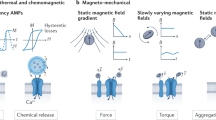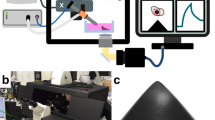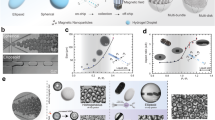Abstract
Complex cell behaviours are triggered by chemical ligands that bind to membrane receptors and alter intracellular signal transduction. However, future biosensors, medical devices and other microtechnologies that incorporate living cells as system components will require actuation mechanisms that are much more rapid, robust, non-invasive and easily integrated with solid-state interfaces. Here we describe a magnetic nanotechnology that activates a biochemical signalling mechanism normally switched on by binding of multivalent chemical ligands. Superparamagnetic 30-nm beads, coated with monovalent ligands and bound to transmembrane receptors, magnetize when exposed to magnetic fields, and aggregate owing to bead–bead attraction in the plane of the membrane. Associated clustering of the bound receptors acts as a nanomagnetic cellular switch that directly transduces magnetic inputs into physiological cellular outputs, with rapid system responsiveness and non-invasive dynamic control. This technique may represent a new actuator mechanism for cell-based microtechnologies and man–machine interfaces.
This is a preview of subscription content, access via your institution
Access options
Subscribe to this journal
Receive 12 print issues and online access
$259.00 per year
only $21.58 per issue
Buy this article
- Purchase on Springer Link
- Instant access to full article PDF
Prices may be subject to local taxes which are calculated during checkout




Similar content being viewed by others
References
Fromherz, P., Offenhausser, A., Vetter, T. & Weis, J. A neuron–silicon junction: a Retzius cell of the leech on an insulated-gate field-effect transistor. Science 252, 1290–1293 (1991).
Young, T. H. & Chen, C. R. Assessment of GaN chips for culturing cerebellar granule neurons. Biomaterials 27, 3361–3367 (2006).
Sutton, B. J. & Gould, H. J. The human IgE network. Nature 366, 421–428 (1993).
Lu-Kuo, J. M., Joyal, D. M., Austen, K. F. & Katz, H. R. gp49B1 inhibits IgE-initiated mast cell activation through both immunoreceptor tyrosine-based inhibitory motifs, recruitment of src homology 2 domain-containing phosphatase-1, and suppression of early and late calcium mobilization. J. Biol. Chem. 274, 5791–5796 (1999).
Segal, D. M., Taurog, J. D. & Metzger, H. Dimeric immunoglobulin E serves as a unit signal for mast cell degranulation. Proc. Natl Acad. Sci. USA 74, 2993–2997 (1977).
Oka, T. et al. IgE alone-induced actin assembly modifies calcium signaling and degranulation in RBL-2H3 mast cells. Am. J. Physiol. Cell Physiol. 286, C256–C263 (2004).
Matthews, B. D., LaVan, D. A., Overby, D. R., Karavitis, J. & Ingber, D. E. Electromagnetic needles with submicron pole tip radii for nanomanipulation of biomolecules and living cells. Appl. Phys. Lett. 85, 2968–2970 (2004).
Matthews, B. D., Overby, D. R., Mannix, R. & Ingber, D. E. Cellular adaptation to mechanical stress: role of integrins, Rho, cytoskeletal tension and mechanosensitive ion channels. J. Cell Sci. 119, 508–518 (2006).
Matthews, B. D. et al. Mechanical properties of individual focal adhesions probed with a magnetic microneedle. Biochem. Biophys. Res. Commun. 313, 758–764 (2004).
McCreary, C. R., Dixon, S. J., Fraher, L. J., Carson, J. J. & Prato, F. S. Real-time measurement of cytosolic free calcium concentration in Jurkat cells during ELF magnetic field exposure and evaluation of the role of cell cycle. Bioelectromagnetics 27, 354–364 (2006).
Glogauer, M., Ferrier, J. & McCulloch, C. A. Magnetic fields applied to collagen-coated ferric oxide beads induce stretch-activated Ca2+ flux in fibroblasts. Am. J. Physiol. 269, C1093–C1104 (1995).
Meyer, C. J. et al. Mechanical control of cyclic AMP signalling and gene transcription through integrins. Nature Cell Biol. 2, 666–668 (2000).
Bromley, S. K. et al. The immunological synapse. Annu. Rev. Immunol. 19, 375–396 (2001).
Schreiber, A. B., Libermann, T. A., Lax, I., Yarden, Y. & Schlessinger, J. Biological role of epidermal growth factor-receptor clustering. Investigation with monoclonal anti-receptor antibodies. J. Biol. Chem. 258, 846–853 (1983).
Kim, E., Cho, K. O., Rothschild, A. & Sheng, M. Heteromultimerization and NMDA receptor-clustering activity of Chapsyn-110, a member of the PSD-95 family of proteins. Neuron 17, 103–113 (1996).
Rothberg, K. G., Ying, Y. S., Kamen, B. A. & Anderson, R. G. Cholesterol controls the clustering of the glycophospholipid-anchored membrane receptor for 5-methyltetrahydrofolate. J. Cell Biol. 111, 2931–2938 (1990).
Tanase, M. et al. Assembly of multicellular constructs and microarrays of cells using magnetic nanowires. Lab. Chip 5, 598–605 (2005).
Koo, Y. E. et al. Brain cancer diagnosis and therapy with nanoplatforms. Adv. Drug Deliv. Rev. 58, 1556–1577 (2006).
Bulte, J. W. & Kraitchman, D. L. Iron oxide MR contrast agents for molecular and cellular imaging. NMR Biomed. 17, 484–499 (2004).
Grynkiewicz, G., Poenie, M. & Tsien, R. Y. A new generation of Ca2+ indicators with greatly improved fluorescence properties. J. Biol. Chem. 260, 3440–3450 (1985).
Song, J., Chen, J., Klapperich, C. M., Eng, V. & Bertozzi, C. R. Functional glass slides for in vitro evaluation of interactions between osteosarcoma TE85 cells and mineral-binding ligands. J. Mater. Chem. 14, 2643–2648 (2004).
Overby, D. R., Matthews, B. D., Alsberg, E. & Ingber, D. E. Novel dynamic rheological behavior of individual focal adhesions measured within single cells using electromagnetic pulling cytometry. Acta Biomaterialia 1, 295–303 (2005).
Sukharev, S. I., Sigurdson, W. J., Kung, C. & Sachs, F. Energetic and spatial parameters for gating of the bacterial large conductance mechanosensitive channel, MscL. J. Gen. Physiol. 113, 525–540 (1999).
Acknowledgements
The authors acknowledge helpful input from J. Pendse, B. Matthews, S. Xia and R. Rogers, the use of SEM equipment at the Harvard Center for Nanoscale Systems, support from a NIH postdoctoral fellowship to S.K. (F32-NS048669), and a DARPA grant (N000140210780). The authors also wish to thank Kristin Johnson for her artwork and MagneSensors for assistance with bead magnetization measurements.
Author information
Authors and Affiliations
Contributions
R.J.M. carried out experimental work, data analysis, method development, calcium analysis and wrote the paper. S.K. was responsible for experimental design, establishing the cell system and manuscript preparation. F.C. was involved with scanning electron microscopy and data analysis, M.M-Z. with electromagnetic needle construction and experimental work, and E.F. with finite-element modelling. M.P. supervised the design of the finite-element model, and D.E.I. devised the technology concept, supervised the project, and was involved in data interpretation and manuscript preparation.
Corresponding author
Supplementary information
Supplementary Information
Supplementary methods, supplementary figures S1–S3 and caption to supplementary movie (PDF 858 kb)
Supplementary Information
Supplementary movie (MOV 470 kb)
Rights and permissions
About this article
Cite this article
Mannix, R., Kumar, S., Cassiola, F. et al. Nanomagnetic actuation of receptor-mediated signal transduction. Nature Nanotech 3, 36–40 (2008). https://doi.org/10.1038/nnano.2007.418
Received:
Accepted:
Published:
Issue Date:
DOI: https://doi.org/10.1038/nnano.2007.418
This article is cited by
-
Nanoparticle-mediated cancer cell therapy: basic science to clinical applications
Cancer and Metastasis Reviews (2023)
-
Urchin-like magnetic microspheres for cancer therapy through synergistic effect of mechanical force, photothermal and photodynamic effects
Journal of Nanobiotechnology (2022)
-
Modulating cell signalling in vivo with magnetic nanotransducers
Nature Reviews Methods Primers (2022)
-
Directed manipulation of membrane proteins by fluorescent magnetic nanoparticles
Nature Communications (2020)
-
Engineering improved measurement and actuation for nanoscale biophysics
Biophysical Reviews (2020)



